|

(click to enlarge) |
|
| Column #21 - Euros + Euros + Worlds |
|
The summer is here. For most people, the summer means holidays, parties, beach time and relaxation. But for me the summer means a completely full racing calendar, a lot of nitro smell, dust, stress, excitement, and thrilling moments. With the racing schedule on my calendar I knew that we would not be bored during the summer at all.
The summer and the autumn are loaded with European and World Championships in all the categories where we have been active â“ electric & nitro touring cars and off-road cars. Additionally we had the European Championship âśBâť in both nitro touring & off-road⦠no rest for the weary. |
|
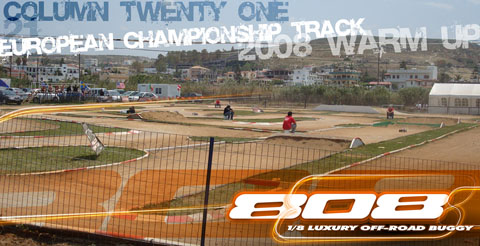
(click to enlarge) |
|
|
|
On a late evening on Saturday I am still in the office, having just finished packing all our stuff for the off-road Euros. At 2 AM we will be leaving for Greece for another major race of the season. And in the last few minutes I am putting together this column for you, to disclose the last few weeks and months in my life⦠and then Iâ™ll be heading to the race track to kick off the summer season, the racing season.
This new never-ending cycle started for us just after the release of the new XB808. First the very positive feedback and reports from team drivers and customers made all of us very happy and satisfied for the very hard work in the last year. But we could not rest on any laurels, rather we had to continue the work pace and prepare the car and team for the upcoming Euros, US Championship, and Worlds. |
|
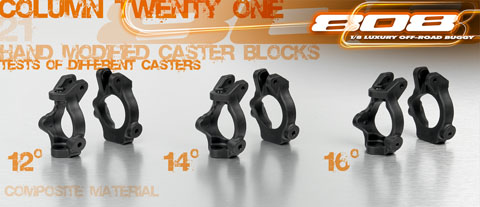
(click to enlarge) |
|
|
|
| Josh Wheeler ⓠUS team driver ⓠshowcased the XB808 at the recent US Championship and despite not getting a podium finish due to engine troubles in the main final, clearly showed the performance and handling by setting the fastest lap time and not only one, but 5⦠then 10 laps! This consistent performance shows us all that the XB808 works well not only on European tracks but also on US-style tracks as well, giving us good expectations for upcoming events and confirming why the regular drivers (customers) are so happy and satisfied with the car. |
|
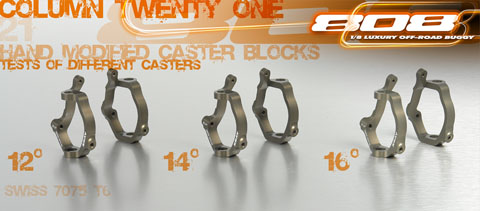
(click to enlarge) |
|
|
|
| Continuing the work on the XB808, we have prepared several new option parts which were going to be tested at the Euros warm-up. To allow complete geometry adjustment for precise set-up tuning for high-performance racing, we have created 12°, 14° and 16° caster blocks from aluminum as well as hand-modified composite versions; both provide very different handling characteristics. Additionally we prepared adjustable rear alu uprights and created a thicker aluminum chassis all of which are for additional set-up adjustment. In addition to these mentioned parts, there were also other parts that were purpose-designed to reduce the weight: aluminum wheel axles, aluminum pivot balls, aluminum lightweight turnbuckles, etc. All these parts were prepared in complete sets and delivered to the team drivers for long-term testing and objective feedback. |
|
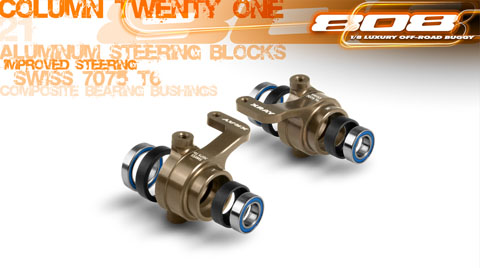
(click to enlarge) |
|
|
|
| After several different tests, we all felt that the original chassis was better as the thick chassis was simply too stiff. Many team drivers were very satisfied with the increased caster, though. We did a lot of tests comparing the standard 10° and the new 12°, 14° and 16° caster blocks and especially we were doing a lot of comparison between the composite versions and the aluminum versions. Each one provided very different yet specific handling characteristics. On bumpy tracks, the larger caster values makes the car more easy to drive (for me at least) but at the same time the car loses a bit of steering while off-power. It is all about the personal feeling and preference and of course racing style. I prefer a more forgiving and easy-to-drive car so I can concentrate on racing instead of fighting with the car, and as such the higher caster values made my car easier to drive and I made less mistakes, thus giving me better overall results. But at the Euros B I had to return to the standard caster blocks because the track was very smooth and flat and here I needed more steering. As a solution, the new aluminum steering blocks provided exactly the same set-up but with higher and more precise steering without losing traction. |
|
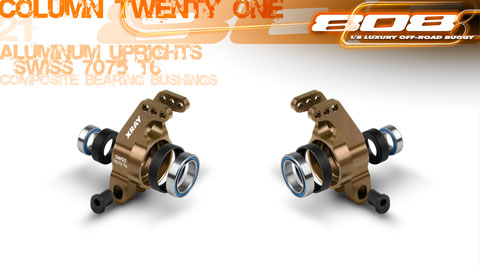
(click to enlarge) |
|
|
|
The Euros B was a very good practice and we had a great time. We did a lot of testing and the customers have greatly appreciated the support and the tech meetings we had. I was talking to every XRAY driver personally, giving advice and technical help. It was great to get feedback and experience from those private drivers.
By recording all the data during the testing of new parts, the team gained invaluable knowledge for the upcoming Euros A. All option parts which had positive results and feedback were forwarded to the design studio to finish the parts for mass production using the improvement ideas collected during the tests: final shape redesign, reinforcement, improved suspension geometry design, and then redesigning areas which would be difficult to mass produce. Soon any XRAY customer can have a chance to buy the same option parts as used by the team and adjust the car for specific racing conditions. Some of the parts are purely for high-competition use only (reducing the weight), while some are valuable tuning parts which allow fine set-up adjustment. On the other hand, some parts which did not give any obvious benefits (for example the thicker chassis) will not go into production as I want to make sure that customers will have access to those parts which will improve the carâ™s performance or handling, or provide some other benefit. |
|
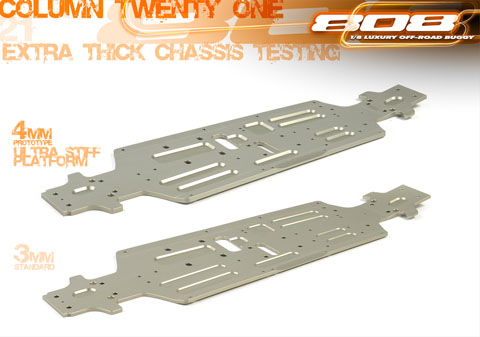
(click to enlarge) |
|
|
|
| With all recent new experiences and improvement parts we are ready for the upcoming Euros. It is going to be a very difficult race and there can be only one winner and with so many very strong teams and so many different companies and brands fighting for the one title only, it will be a very difficult race. But we will do our very best both on and off the track. The support team will be available at the track with the XRAY tent for service and support area providing all the material, technical, and set-up help to all XRAY drivers. Team XRAY is well prepared and I am ready as well for the bumps, jumps, dust and sand. All we need now is a bit of good luck. |
|

|
Enjoy the ride and â�til the next time.
Dipl. Eng. Juraj Hudy
Chief designer XRAY |
|

(click to enlarge) |
|
| Column #22 - Electric Touring Car Euros Preparation |
|
| While other RC car designers are usually focused on one category only and spend their time with testing, working, developing and designing one type of the car, I have a slightly more complicated life as an RC car designer: I have to do all. With the Euros and Worlds in all the categories we are active in, I had to constantly switch my mind between all the categories. Many times after we finished a partial project on a particular car, I had to switch to the other categories to ensure that we do not forget anything. As such, it was very typical in the last months that coming from an off-road race we forwarded all our experience, improvement ideas and feedback to our R&D team⦠and then the same day go to the touring car tracks to work on both electric and nitro touring car development. This has become a constant daily routine. |
|
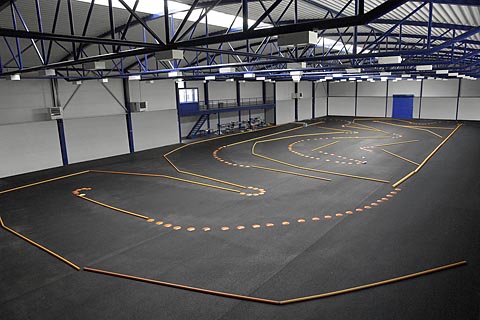
(click to enlarge) |
|
|
|
With our own factory indoor track, life has been made a bit easier. Martin built a copy of the Euros track layout and we gathered all the recent improvement ideas we had and prepared all the prototype parts for testing. The performance, handling, durability, and geometry have all been at the highest level for our T2â™008 and as such we could focus on the smaller details (especially on reducing weight) and test different drivetrain parts. I have been testing the new double drive shafts for a long time; these are perfect when the front solid axle is used as the double drive shafts equalize the corner speed and eliminate vibration from the axle to the drive shafts.
As the development and trend has moved towards using the front solid axle almost exclusively with rubber tires, it was an obvious priority to focus on improving the efficiency of the car with the solid axle. The very first prototypes had a durability problem when the drive shaft bent during a crash. We had to change the design significantly. The first tests of the newly-redesigned double drive shafts were very positive as I had a couple of serious crashes and nothing broke. The drive through the corners is now much smoother. |
|
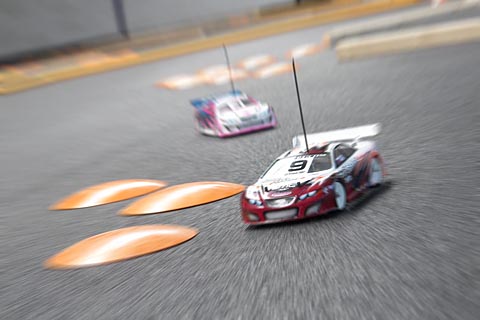
(click to enlarge) |
|
|
|
| We would run the car with a solid axle at the European Championship, so the project of the drive shaft was successfully finished. Now we had to concentrate on solving another issue: breakage of the solid axle outdrives in serious crashes. With the high competition of the European Championship, you could not afford to make a single mistake in your runs if you wished to have a good result. Still, I wanted to have a back-up solution for the solid axle so that even if a mid-pack driver like myself crashed, s/he could still finish the run. |
|
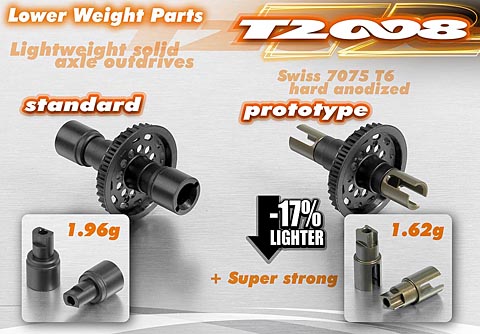
(click to enlarge) |
|
|
|
| The advantage of the current solid axle is that the composite design makes it super lightweight and of course with the lowest rotating weight concern I wanted to solve the breakage issue. But I did not want to make any solution that lost the benefit of light weight. The first idea was to mix some different composite mixtures. During a few days of testing, I was not happy with the results and so I decided to make some radical change: replacing the composite outdrives with aluminum versions. To keep the lowest possible weight we used super-lightweight but extra-durable Swiss 7075 T6 which allowed us to make the outdrives really light weight and the final surface hardcoating ensured that wear will be minimal. With this design we had to use the drive shaft composite clips, though. |
|
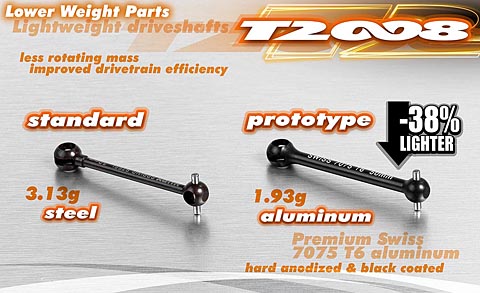
(click to enlarge) |
|
|
|
To reduce the weight of the drivetrain parts, we produced a few different drivetrain parts from different materials for long-term performance and durability tests. The positive outcome was aluminum drive shafts with special lightweight steel outdrives. The aluminum drive shafts â“ while hardcoated for durability â“ are still considerably softer than the original steel versions and in serious crashes could still bend a bit more easily in the front of the car. As such, for safe runs I suggest using the aluminum drive shafts only at the rear.
During a couple of weeks of testing at the Euros track layout, we had great progress in testing, running, and comparing all the new parts. Many parts gave no improvement and as such were put aside for later development in some different racing conditions where maybe they may be a benefit. There were, though, a few parts which seemed to give reliability improvements as well as parts with reduced weight which I am very positive above. These will probably go into mass production depending on their long-term results. |
|
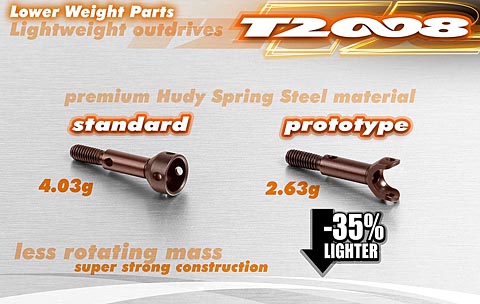
(click to enlarge) |
|
|
|
The one part I had very mixed feelings above was definitely the thinner chassis. For very low traction tracks, I was looking to gain some extra flex in the car using different Multi-Flex™ settings. Releasing the screws in the top deck and chassis and using the new thinner top deck helped a lot and for my level of racing was good enough. But Martin was still not completely happy at the low traction tracks and so we produced a couple of different chassis of different thicknesses. Early this year we did first testing at TITC in Thailand, the track where the World Championship would take place. After a few tests we all returned to the standard chassis as the thinner one generated so much grip that we were losing cornering speed.
We have packed all our stuff, the new prototypes and all the latest experiences, and we will be heading out to join Teemu Leino, Alex Hagberg, Steven Weiss, and Dirk Wischnewski for a private testing in Spain for the Euros track, to have direct and personal hands-on experience on the particular track, asphalt and particular conditions only 2 weeks before the actual Euros. Even if the grip will be very different, the weather conditions should be fairly similar and we have lots and lots of things and ideas to test. After we return we will have just over one week to prepare for the Euros and regain all the power, energy and motivation to face all the factory teams and best drivers around the Europe to fight for the prestigious title⦠a title which was very close to our grasp for so many years but which fate has prevented us from claiming. Hopefully this time we have a bit more good luck. See you at the track. |
|

|
Enjoy the ride and â�til the next time.
Dipl. Eng. Juraj Hudy
Chief designer XRAY |
|























